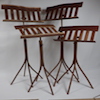How do I make a template to router a recess to fit the oval coin slot in the attached picture? I am making several coin banks with post office box doors and the oval coin slot pictured. I would like to router a template and then using the template router a pocket so the cast brass coin slot sits almost flush with the top of the wood. The picture is of the back side of the brass coin slot by the way.




 Reply With Quote
Reply With Quote



 I know what i did wrong. Based my calculations on the wrong edge of the bushing/router bit. It is a rainy Monday so I will have tine this afternoon to try it again.
I know what i did wrong. Based my calculations on the wrong edge of the bushing/router bit. It is a rainy Monday so I will have tine this afternoon to try it again.

